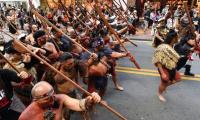The war of Independence in 1857, in which all ethnic groups took active part, was the climax of upfront resistance to the British Raj. The passionate freedom fighters, however, could not cope with the might of the East India Company with its superiority in terms of latest weapons, a highly-trained army and strategic organisation.
The post-1857 situation in British India was thus depressing for Indians, Muslims in particular. The economic exploitation of foreign rule led to mass-scale poverty in India. The British Raj made trespasses in the social, cultural and religious lives of local Indians. The political challenge for the Muslims was that, being dethroned from power, their identity was changed overnight. From rulers of the country they were simply reduced to a minority group that lagged behind others in terms of education, economy, and placement in government jobs.
Post-1857 scenarios required a different strategy of resistance. In my previous article on these pages I referred to a revised strategy of resistance through education by some eminent religious leaders who set up Darul Uloom Deoband in 1866. It is important to note that the people behind the establishment of Darul Uloom Deoband had played an active part in the War of Independence in 1857. The establishment of Darul Uloom Deoband was based on the diagnosis that the reason for the fall of Muslims was their detachment with religion and morality, which led to their weakness and indignation.
A few years later, Syed Ahmed Khan, popularly known as Sir Syed, came up with a different diagnosis of Muslims’ socio-economic ailment. According to him, the reason for the fall of the Muslims was their disinterest in the modern education of science and technology.
Before we look at the contribution of Sir Syed’s Aligarh University, it is pertinent to briefly look at the challenges posed by the British Raj in India. There was economic exploitation by the Raj. As a result of this, local peasants and craftsmen had lost their jobs. On the educational front, the local system of education lost state patronage. The alternative educational system offered by the British was asymmetrical, and not accessible to a large number of people in India.
Another challenge was the active work of missionaries who were converting poor people in India to Christianity. A related challenge was the onslaught of unfounded criticism on Islam by the West; this was affecting people’s minds. There was an understandable detachment between Muslims and the British Raj, and the War of Independence had further enhanced the aloofness of Muslims. This isolation was not doing any good to the Muslims. Rather they were ignored in government jobs and their social visibility in the corridors of powers was diminishing.
In this backdrop, Sir Syed decided to carve a different path to empower Muslims, a path which would not lead to upfront clashes with the Raj but which would equip the Muslims with contemporary education and skills to regain their social status in India.
Sir Syed was aware of the fact that the challenge in front of him was huge and needed a comprehensive response. Thus, we see the Aligarh movement as a holistic response to deal with the challenges faced by the Muslims. There were various components of this movement that were knitted together, leading to the objective of the empowerment of Muslims.
One component of this movement was producing literature to create socio-political awareness among the Muslims. To this end, Sir Syed wrote a number of books. His magazine, ‘Tehzeeb ul Akhlaq’, was an organ of social reform that played an important part in social education of Muslims. Another challenge taken up by Sir Syed was the unfounded criticism on Islam and important personalities of Islam. He wrote a logical and convincing response to debunk the negative stereotypes promoted by Western writers.
On the political front Sir Syed realised that Muslims, being a minority, would be left behind in the traditional democracy in India. It is important to note that this was a starting point for the Two-Nation Theory. This idea was further clarified during the Simla deputation by Sir Syed’s successor Nawab Mohsinul Mulk, with the demand for separate electorate for the Muslims for a legitimate representation of Muslims. It is important to note that the foundation of the All India Muslim League was laid on the occasion of the Educational Conference held at Dhaka in December 1906.
The central part of the Aligarh movement, however, was the educational initiatives of Sir Syed. Sir Syed, during his visit to Europe in 1869, closely studied the educational system there. His dream of setting up a school with a blend of local and global curricula was realised in 1875 when he established such a school in Aligarh.
The school was soon upgraded to the Mohammadan Anglo Oriental College – a residential college that aimed at providing a holistic education to the students. That is why, besides classroom teaching, there was equal emphasis on extracurricular activities like sports and debates etc. The college was later upgraded to the Muslim Aligarh University in 1920. The aim of Aligarh College – empowerment of Muslims – was supported with other initiatives like the Muhamamdan Educational Conference and Scientific Society, etc.
The Aligarh movement, with its pivotal component of Aligarh University, offered the Muslims a hope by equipping them with modern education and inculcating in them socio-political awareness. This peculiar brand of nationalism of Aligarh was a subtle form of resistance that prepared and produced graduates who could think for themselves and could communicate their viewpoint in a logical and convincing manner.
It was these graduates of Aligarh who became a vibrant force in Jinnah’s movement for a separate homeland, the seed for which was sown long before by Sir Syed Ahmed Khan.
The writer is an educationist.
Email: shahidksiddiqui@gmail.com
Five people were killed, including one of the guards after being hit over the head with a fire extinguisher
Pakistan has a long way to go in providing equitable digital access to its population of nearly 250 million
Every country has myriad of Marxist factions claiming to be global and universal in nature
We need to look deeper to see if there is indigenous growth model better attuned to aspirations of Pakistani public
Those who wield technology not only change their destiny but alter very definitions of power
Pakistan should, in the long run, aim for geographical diversification for its products to mitigate external shocks







